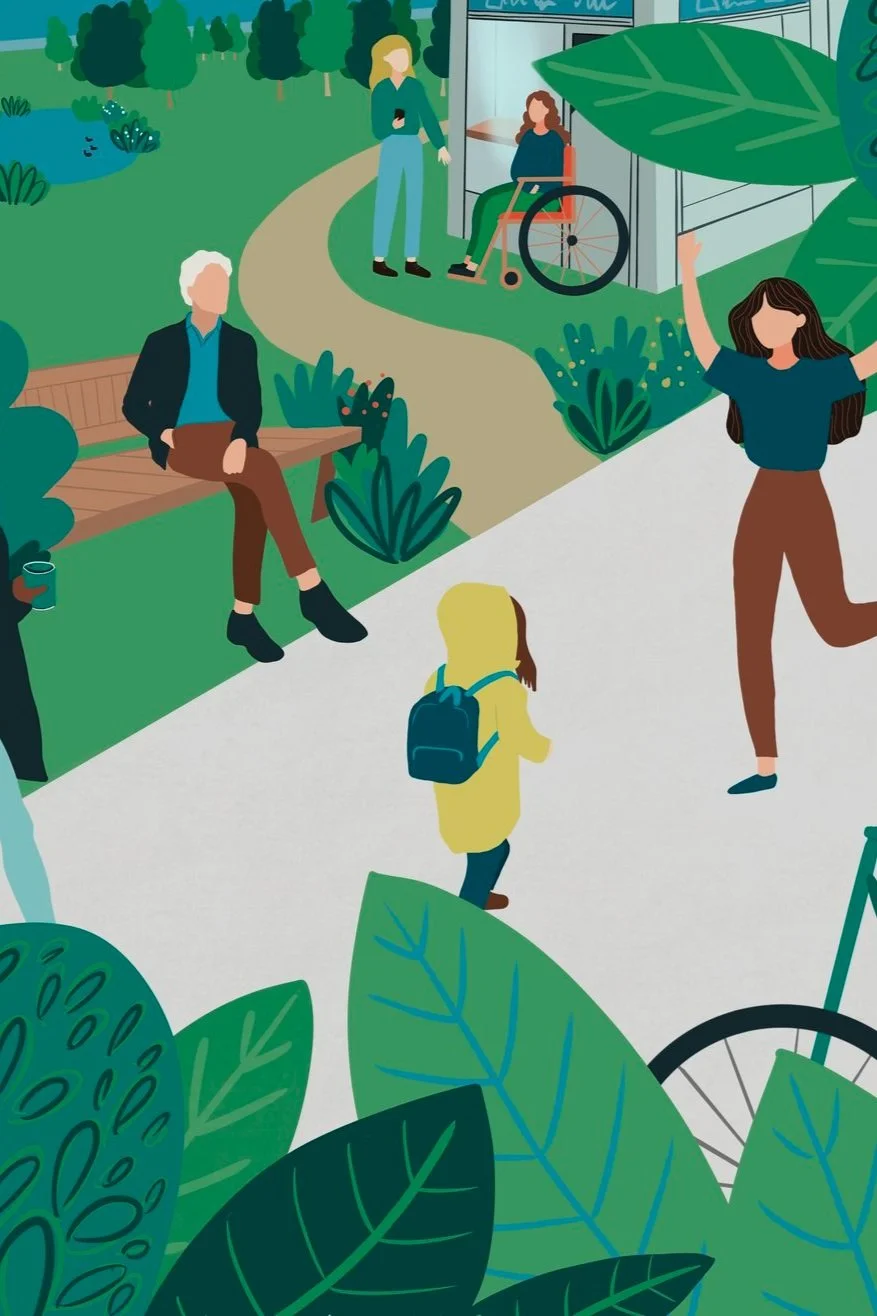Initial PhD Findings: delivering better public spaces
This page summarises my initial findings from surveys with 77 built environment practitioners about: their aspirations for ‘better’ public spaces, the everyday professional challenges they experience in delivering this, and the changes they would prioritise to help address these, as part of Jenny Elliott’s PhD research.
I also recently interviewed 62 built environment professionals working in the design, planning, delivery or management of public spaces in the UK and am currently running a series of in-person and online workshops to finalise findings ready for share a series of recommendations with policymakers, practitioners and industry bodies later in 2023.
Jenny Elliott’s PhD research is at the University of Edinburgh, in collaboration with industry partner Connected Places Catapult and funded by SGSAH. More info and an overview of the research is here.
Emerging themes:
(Under) valuing ‘landscape’ and ‘nice to have’ elements of public spaces - Practitioners - especially in private consultancy - feel value engineering significantly impacts public space place outcomes. In particular, ‘landscape’ elements or other aspects that would improve the overall quality, environmental or social aspects of public space are seen as ‘non-essential’ and omitted or reduced toward the end of projects in favour of other architectural/engineering built infrastructure.
Short-term budgets, political and funding cycles, and under-resourced, over-stretched local authorities are at odds with communicating, planning for, and delivering on, long-term value, vision and ROI - For example, practitioners feel a lack of adequate provision for longer-term, ongoing maintenance restricts choices and quality of green and built infrastructure able to be implemented in public spaces. This relates to a wider under-resourcing of local authorities and under-appreciation of the value landscape, green and active travel infrastructure provide. More education and CPD is needed for clients, political leaders, policy-makers, and built environment professionals and related disciplines of the ROI and other value ‘good’ public space provides - particularly green infrastructure (e.g. SUDS, mature trees) to enable them to champion this more effectively and allocate budgets that recognise long-term maintenance, improvement and vision. Changes to systems and processes for funding and delivering these long-term to achieve wider public health and environmental benefits.
The impact of culture in creating inertia or compromise. For example, car culture among some professionals who view smooth traffic flow as the primary measure of success of a well-functioning street instead of wider indicators, and societal car culture results in local resident objections to reallocation of street space away from car parking/lanes - creating political pressure against and reducing the boldness of moves toward greener, healthier places due a desire to avoid ‘risky’ bolder change or negative PR. Organisational culture and structure within local authorities can also dampen progress - with key challenges around moving away from multi-layered top-down hierarchical structures and toward more agile, horizontal, collaborative, communicative structures that foster a culture of experimentation (and preparedness to fail), promote officer-level initiative and lead from the front in testing ambitious ideas - working together cross-department toward mission-led goals (public health, climate change etc) and using these as the measure of success.
Tensions between private interests (car culture resulting in resistance removing car-parking that benefits individuals, commercial developers’ focus on profit) and broader public ‘good’ (health, well-being, social, environmental) outcomes that play out in complex ways in public spaces with multiple stakeholders and impacts. This can negatively impact place outcomes where private interests and public benefit are not aligned and there is not strong enough provision of policy, planning or legislative measures to safeguard the best outcomes. Typically ‘public good’ outcomes are longer term, harder to measure or more dispersed than more direct links and private short-term gain making them harder to prioritise.
A need for a bolder, long-term, politically supported and funded vision for more ambitious public spaces. Bolder, more ambitious policy, leadership and accountability, in recognition of the need for urgent and widespread improvements given the climate crisis and daily impact of public space on citizen health and well-being. Increased public sector funding enabling local authorities to lead from the front.
Survey Findings
Practitioners’ aspirations for public space
What are built environment professionals aspiring to in terms of ‘best practice’ for public spaces?
Most practitioners mentioned they see ‘ideal’ public spaces as including and prioritising 3 key elements":
High quality active travel infrastructure promoting walkability, inclusion and sustainable transport modes.
Diverse, plentiful and well-maintained green infrastructure - particularly SUDS and mature trees.
Transparent, early, two-way engagement and placemaking - to promote inclusion, social connection and stewardship and ensure positive user experience and context-appropriate design.
How often are we achieving this?
How often do built environment professionals think we are achieving these aspirations?
Only 4% of the built environment practitioners surveyed felt a self-chosen local familiar urban public space they were thinking of “definitely aligned with ‘best practice’”. 20% felt the public space chosen “did not align at all” with best practice.
Only 16% felt - as an industry - we are frequently achieving ‘best practice’ public spaces in practice.
25.7% of practitioners felt as an industry we are ‘rarely’ achieving best practice for our public spaces.
Despite these statistics, practitioners had a clear idea of their aspirations for what a ‘good’ public space should be like. This raises the question - what are the barriers preventing them from delivering ‘ideal’ public spaces in practice?
Barriers and challenges to delivering best practice
What are the barriers to delivering ‘best practice’ public spaces more consistently?
Systemic undervaluing of landscape - evidence-base of value and ROI insufficiently known/communicated to decision-makers. Beneficial elements often reduced, omitted or deprioritised at value engineering.
Car culture - a need for public culture/behaviour change toward green infrastructure and sustainable transport choices, and to support political leaders advocating for this.
Lack of strong, clear policy and bold leadership to ensure best practice is delivered and held accountable.
Legacy public realm condition - in particular, car-dominated infrastructure choices.
Insufficient public funding - this reduces local authorities’ ability to adopt, maintain or enhance ‘best practice’ public realm elements.
Inadequate community engagement - lack of transparency and clear links to decision-making.
What needs to change to address these barriers?
What do practitioners feel solutions might be? What would help? Which change would have most impact?
Stronger, clearer, robust planning policy and legislation - to ensure ‘best practice’ public space design achieved as a minimum, and accountable, even where this pushes people beyond comfort zones.
Embed more landscape architects in local authorities - to champion cross-disciplinary working, green infrastructure and contextual design.
CPD/education for public space practitioners, political leaders and public on the evidence-base showing value, ROI and benefits of ‘best practice’ public space qualities to help enable them champion and support this. Particularly, the value of good walking, cycling and green infrastructure and the reasons this should be prioritised over cars.
Ringfence landscape budgets to avoid reductions in quality at value engineering, and reallocate budgets to better prioritise elements delivering most positive impact.
Increase budgets in line with bolder ambition, vision and more long-term thinking - particularly for local authorities, allowing them to drive innovation, and lead from the front for better public spaces.
Holistic, interdisciplinary approaches and greater collaboration across local authority teams, consultancies and other stakeholders. Mechanisms to foster better communication and exchanges of information that build on each groups’ expertise.
Integrating pre-start place audits and post occupancy evaluation (POE) as standard for public space projects and ongoing management, not just when resource allows. Crucially - with a mechanism to ensure these influence and change ongoing systems, practice and process based on findings.
Would novel data insights or digital tools/tech help?
What role - if any - might urban data, emerging technologies or digital tools play in these solutions?
Public space professionals surveyed primarily used tech for 2D/3D design purposes, communicating with colleagues and facilitating on-line community engagement, and - to a lesser extent - remote surveying and monitoring, open source data-sharing, and to help analyse or digitally visualise (VR, AR) future scenarios.
Many practitioners felt trends toward use of VR and AR to visually communicate future designs or plans with stakeholders, or spatial dashboard approaches centralising urban data, plans, and project information whilst facilitating citizen engagement would be beneficial.
Public space professionals currently use data insights to impact decision-making primarily via informal self-reflection of previous projects (80% of practitioners) or discussion with colleagues (78%), followed by formalised passive site survey methods to gather new data (39%-72% by method), and then two-way discussion and engagement with stakeholders (32-56% by method). POE was least used.
Only 17% of practitioners surveyed had used place occupancy evaluation (POE) in the last 2 years. This is despite 79% saying POE was a worthwhile use of time and resources, and only 15% feeling there is currently a strong feedback loop between learnings from past projects and current/future public space projects. Increasing use of POE and ensuring a mechanism to share these data insights forward would be beneficial.
There is demand to use more urban data insights, digital tools and technologies supporting public space design and decision-making, but lack of time, knowledge and resource were key issues preventing this for most practitioners surveyed. Only 9% said they didn’t feel the need to use data-driven techniques, digital tools or technologies - feeling they weren’t worth the time/resource input required. Many practitioners supported the increased use of digital tools, platforms, and other tech - alongside in-person methods - to increase reach / insights from community engagement and support visual communication of plans / proposed changes.
Or is this more about policy, system or practice?
Or would other changes to policy, systems or practice be more appropriate?
Public space professionals suggested numerous changes to policy, systems or practice that would positively impact place outcomes, some of which may be assisted by data/tech innovations - others less so. These will be further explored along with other findings via ongoing interviews with practitioners. However emerging findings suggest:
We need a mechanism to enable more contextual user-experience and place data to feed into ‘live’ decision-making for public spaces, and for POE to not just sit as ‘reports on shelves’ but actively challenge and change systems, policy and practice to improve future outcomes and be shared across the industry.
We need stronger, clearer policy - led by ambitious and informed public space champions and leaders, to get everyone on the same page and collaborating toward the same end goals, with the adequate and targeted budgets to ensure long-term ROI for ‘best practice’ public spaces are realised, with key (particularly landscape) elements ringfenced to ensure delivery, and accountability where (ambitious) minimum standards are not met.
We need to better link research and the ‘evidence-base’ of the value and ROI of green and active travel infrastructure, and placemaking on health, well-being and environment, and mainstream this knowledge across citizens, political leaders, clients and professionals so that ‘best practice’ public spaces become a commonly understood and valued goal - from top-down client briefs (and budget), to bottom-up advocacy and support from the public.







